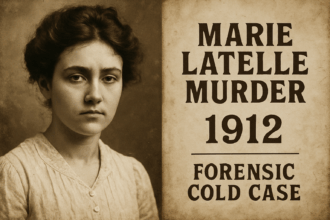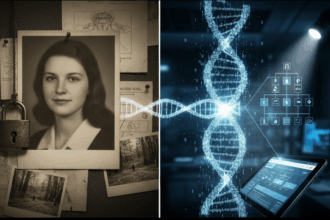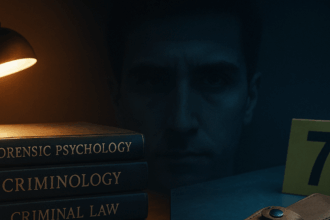Imagine solving a murder without fingerprintsFingerprint, impression made by the papillary ridges on the ends of the fingers and thumbs. Fingerprints afford an infallible means of personal identification, because the ridge arrangement on every finger of every human being is Read Full Definition, DNA DNA, or Deoxyribonucleic Acid, is the genetic material found in cells, composed of a double helix structure. It serves as the genetic blueprint for all living organisms. Read Full Definition, or surveillance cameras—just a torn piece of newspaper. In 1784, a single scrap of paper became the key to unraveling a deadly mystery. The John Toms trial is one of the earliest documented instances where physical evidence directly secured a conviction in court. This is the story of how one small clue changed the course of crime scene investigation history forever.
DNA, or Deoxyribonucleic Acid, is the genetic material found in cells, composed of a double helix structure. It serves as the genetic blueprint for all living organisms. Read Full Definition, or surveillance cameras—just a torn piece of newspaper. In 1784, a single scrap of paper became the key to unraveling a deadly mystery. The John Toms trial is one of the earliest documented instances where physical evidence directly secured a conviction in court. This is the story of how one small clue changed the course of crime scene investigation history forever.
- Historical Context and Background
- The Crime: Edward Culshaw’s Murder
- Edward Culshaw’s Final Journey on the Liverpool Road
- The Discovery of the Body and Initial Investigation
- The Investigation and Breakthrough Evidence
- The Trial and Conviction of John Toms
- The Proceedings at Lancaster Assizes
- Witness Testimonies Against Toms
- The Jury’s Verdict and Sentencing
- Historical Significance in Forensic Science Development
- Evolution into Modern Forensic Ballistics
- Legacy and Impact on Modern Criminal Investigations
- Conclusion: From Newspaper to Modern Forensics
- FAQs
In 1784, the foundation of modern forensic ballistics was established through an extraordinary case of deductive reasoning and material matching. The John Toms case represents a pivotal moment in criminal investigation history, marking the first documented conviction based on physical evidence Evidence is any form of proof, such as objects, materials, or scientific findings, presented to establish or disprove a fact in a legal proceeding. It is used to reconstruct events and link or exclude individuals Read Full Definition matching. This comprehensive analysis explores how a simple torn piece of newspaper became the smoking gun that revolutionized criminal investigations and laid the groundwork for modern forensic science
Evidence is any form of proof, such as objects, materials, or scientific findings, presented to establish or disprove a fact in a legal proceeding. It is used to reconstruct events and link or exclude individuals Read Full Definition matching. This comprehensive analysis explores how a simple torn piece of newspaper became the smoking gun that revolutionized criminal investigations and laid the groundwork for modern forensic science Discover the fascinating field of Forensic Science, the application of scientific principles to legal matters. This post delves into its many disciplines, from DNA analysis to crime scene investigation, its importance in the justice system, Read Full Definition.
Discover the fascinating field of Forensic Science, the application of scientific principles to legal matters. This post delves into its many disciplines, from DNA analysis to crime scene investigation, its importance in the justice system, Read Full Definition.
Historical Context and Background
The late 18th century marked a transformative period in criminal investigations. Before the John Toms case, criminal convictions relied heavily on eyewitness testimony, confessions (often obtained through questionable means), and circumstantial evidence. Scientific methods of linking suspects to crimes were virtually nonexistent, and the concept of forensic evidence was in its infancy. This era saw the emergence of early forensic techniques and the rise of forensic science pioneers who would shape the future of criminal justice.
In 1784, Lancaster, England, was still developing its formal justice system. Flintlock pistols were common weapons of the era, requiring users to load gunpowder and a lead ball into the muzzle, typically secured with paper wadding to keep the components tightly packed. This wadding was often made from whatever paper the shooter had on hand – a seemingly insignificant detail that would prove critical in this groundbreaking case and the evolution of forensic evidence collection.
The Crime: Edward Culshaw’s Murder
A fateful January day in 1784 marked a pivotal moment in forensic history. The quiet roads near Lancaster, England, became the setting for a murder case that would establish fundamental principles of evidence collection and analysis. This case—the Edward Culshaw murder by John Toms—demonstrates how even the most straightforward physical evidence can prove decisive in establishing guilt.
Edward Culshaw’s Final Journey on the Liverpool Road
On January 19, 1784, Edward Culshaw, a house carpenter from Crosby, was making his way home from Liverpool. Carrying his wages in his pocket, Culshaw traveled unaware of the danger that followed him. John Toms, a saddler with criminal intent, had identified Culshaw as a target and stalked him along the journey.
The attack occurred near Ditton Bank Farm in Widnes. With robbery as his primary motivation, Toms approached his unsuspecting victim from behind. In a calculated act of violence, he shot Culshaw directly in the head with a horse pistol. After the fatal shot, Toms robbed the deceased of his pocket watch and money.
What’s particularly notable about this crime was Toms’ attempt to mislead investigators by placing the murder weapon underneath Culshaw’s body. This deliberate action suggests he possessed some understanding of historical criminal investigations during this period, though his knowledge of evidence transfer would prove insufficient.
The Discovery of the Body and Initial Investigation
The finding of Culshaw’s body prompted immediate action from local authorities. They had little to work with beyond the body and the crime scene. With no eyewitnesses to the shooting itself, the investigation might have quickly grown cold in an era before surveillance cameras, DNA testing, or fingerprint analysis.
John Toms quickly became a person of interest, though the exact nature of his relationship with Culshaw or potential motives remains somewhat obscured by history. Investigators needed something more substantial than mere suspicion to secure a conviction, especially without a confession. This case would soon demonstrate the importance of physical evidence analysis in the criminal justice system.
The Investigation and Breakthrough Evidence
The investigation took a remarkable turn during the postmortem examination of Culshaw’s body. The medical examiner discovered something unusual in the victim’s head wound – a small piece of crumpled paper that had been used as wadding in the fatal shot. This paper appeared to be a fragment of a newspaper, setting the stage for one of the earliest examples of forensic document examination in a criminal case.
During their crime scene examination, investigators discovered something crucial—a small piece of paper lodged in Culshaw’s head wound. This was identified as wadding from the pistol shot, used to secure the gunpowder and lead ball in the muzzle, as was standard practice for firearms of that era.
Upon closer examination, the investigators determined this wasn’t just any paper—this paper appeared to be a fragment of a newspaper. This seemingly minor detail would ultimately connect the murderer to his crime in an unprecedented way, showcasing the potential of newspaper evidence in criminal cases.
The investigative process unfolded with remarkable efficiency:
- Examination of the wound revealed the paper wadding
- Identification of the paper as a torn news paper
- Apprehension of John Toms as a suspect
- Search of Toms’ person revealing critical evidence
Later that evening, authorities apprehended Toms as a primary suspect. During their search, constables made an extraordinary discovery that would fundamentally alter the course of the investigation and the history of forensic science. Toms carried in his possession a scrap of paper—a fragment of the very same newspaper whose torn edge perfectly matched the wadding found in Culshaw’s fatal wound.
The First Forensic Material Match in History
In what would become a defining moment in forensic science history, investigators compared the paper wadding recovered from Culshaw’s wound with the torn newspaper found in Toms’s possession. The comparison revealed something remarkable – the paper wadding fit perfectly into the torn section of Toms’s newspaper, creating a complete match in both the printed text and the irregular tearing pattern.
This perfect match established a direct link between Toms and the murder weapon. The evidence was revolutionary – physical proof connecting a suspect to a crime scene through unique material characteristics. The torn edges of the paper functioned similarly to how modern forensic scientists might match bullet striations or DNA fragments, laying the foundation for future forensic evidence matching methods.
Presenting Physical Evidence to the 18th Century Jury
Despite the relatively primitive forensic standards of the era, the evidence presentation at Lancaster Assizes on March 26, 1784 was remarkably straightforward and effective. Unlike modern trials with complex expert testimony and scientific analysis, the physical matching of the paper pieces was demonstrated directly to jurors through visual inspection.
Jurors could personally observe how the wadding fit perfectly against the torn edge of the newspaper from Toms’ pocket. This direct physical demonstration created a powerful visual connection that required no expert interpretation or specialized knowledge. The evidence spoke for itself in the most literal sense, showcasing an early form of forensic reconstruction.
The simplicity of this evidence presentation highlights an important aspect of forensic history – while methods have grown increasingly sophisticated, the fundamental principle remains unchanged: physical evidence creates objective connections between suspects and crimes that testimony alone cannot establish.
The Trial and Conviction of John Toms
When presented in court, this evidence proved compelling. The perfect match between the newspaper in Toms’s pocket and the wadding recovered from the victim’s wound provided jurors with tangible, visual evidence that was difficult to dispute. The prosecution argued that the odds of another person having the exact matching torn fragment were effectively impossible, making this one of the most significant landmark forensic cases of its time.

The Proceedings at Lancaster Assizes
On March 26, 1784, John Toms stood before Judge Willes at Lancaster Assizes facing the grave charge of willful murder. The courthouse atmosphere was charged with anticipation as spectators gathered to witness what would become a landmark case in criminal justice history. While the formal structure of the trial followed conventional 18th-century procedure—with charges read aloud and the defendant given opportunity to respond—this case would distinguish itself through its unprecedented reliance on physical evidence.
The proceedings themselves would have been relatively brief by modern standards. Court sessions during this period typically handled multiple cases in a single day, with murder trials receiving priority due to their severity. The physical evidence in this case, however, allowed for an unusually straightforward presentation of proof against the accused, setting a new standard for forensic evidence preservation and presentation in court.
Witness Testimonies Against Toms
The prosecution built its case around the extraordinary physical evidence connecting Toms directly to the murder weapon. Court documents reveal that authorities testified about discovering Toms with a newspaper fragment whose torn edge matched perfectly with the wadding recovered from Culshaw’s fatal wound[2]. This physical match became the centerpiece of the prosecution’s argument and a prime example of early ballistics evidence in court.
Unlike modern trials with expert witnesses and technical analyses, the evidence presentation was remarkably direct—the torn paper and wadding were physically displayed to jurors, allowing them to observe with their own eyes how the pieces fit together. This approach created an immediate, visceral understanding of Toms’ connection to the murder weapon that required no specialized knowledge to comprehend.
Supporting testimony likely included accounts from those who discovered Culshaw’s body and details surrounding Toms’ apprehension on the evening of the murder. However, it was the physical matching of the paper fragments that provided the most compelling evidence of guilt, showcasing the power of physical evidence analysis in criminal proceedings.
The Jury’s Verdict and Sentencing
After considering the evidence presented, particularly the damning physical match between paper fragments, the jury delivered a guilty verdict against John Toms. Judge Willes promptly pronounced the standard sentence for murder in 18th-century England—death by hanging.
Court records confirm that Toms was executed on the Monday following his conviction. In keeping with common practice for executed murderers of the period, Toms’ body was “given to the surgeons to be dissected”[2]. This final disposition served dual purposes—advancing anatomical knowledge while adding a further punitive element to the sentence, as dissection was widely feared and considered part of the criminal’s punishment.
The case’s lasting significance lies not in the severity of punishment—typical for its time—but in how a simple piece of paper established a principle that would guide forensic science for centuries to come. When two objects contact each other, they create unique patterns of transfer that can later connect a suspect irrefutably to a crime scene, a concept that would become central to forensic science evolution.
Historical Significance in Forensic Science Development
The John Toms case represents a watershed moment in the history of criminal investigations. It is widely recognized as the first documented case where forensic material matching was used to secure a conviction. This precedent established several important principles that would become fundamental to modern forensic science:
- Physical evidence can provide objective proof. The case demonstrated that physical evidence could be more reliable than eyewitness testimony or circumstantial connections.
- Unique characteristics allow for definitive matching. The torn paper’s irregular edges created a one-of-a-kind pattern that could not be replicated, establishing the concept of unique identifying characteristics in evidence.
- Trace evidenceTrace evidence - Physical evidence that results from the transfer of small quantities of materials (e.g., hair, textile fibers, paint chips, glass fragments, gunshot residue particles). Read Full Definition connects perpetrators to crimes. The case showed how materials transferred between crime scenes, weapons, and suspects could be used to establish connections[19].
Evolution into Modern Forensic Ballistics
While rudimentary by today’s standards, the John Toms case laid the foundation for what would eventually become the field of forensic ballistics
The principle established in 1784 – that objects retain unique identifying characteristics when they come into contact with other objects – remains central to modern forensic analysis. Today’s forensic ballistics experts use comparison microscopes and advanced imaging technologies, but they fundamentally apply the same logical principle first demonstrated in the Tom’s case. This evolution showcases the ongoing development of forensic technology and its applications in modern criminal investigations.
Legacy and Impact on Modern Criminal Investigations
The methodical approach used in the John Toms case foreshadowed the development of the scientific method in criminal investigations. Modern forensic experts still follow similar principles of evidence collection, preservation, comparison, and documentation established through cases like this one, highlighting the enduring impact of early forensic techniques on contemporary practices.
This pioneering case demonstrates several enduring principles of forensic science:
- Every contact leaves a trace—the principle, later formalized by Edmond Locard, that perpetrators always leave evidence at crime scenes and take evidence with them.
- Unique patterns create identifiable connections – The understanding that materials can contain distinct patterns, allowing for conclusive matching.
- Physical evidence provides objective proof—the recognition that scientific analysis of physical evidence can provide more reliable conclusions than testimonial evidence alone.
These principles continue to guide forensic science research and shape the future of criminal investigations.
Conclusion: From Newspaper to Modern Forensics
The John Toms case of 1784 stands as one of the most significant milestones in forensic history. A simple torn piece of newspaper fundamentally altered how criminal investigations would be conducted for centuries to come. This case demonstrated that physical evidence could provide more compelling proof of guilt than any witness testimony or confession.
The power of this case lies in its elegant simplicity. The perfect match between two paper fragments—the wadding recovered from Culshaw’s fatal wound and the newspaper found in Toms’ pocket—created an irrefutable connection between suspect and crime scene. This physical correspondence offered what testimony alone could not: objective proof of involvement that required no interpretation or credibility assessment.
This successful prosecution marked a pivotal transition in criminal justice, establishing three fundamental principles that continue to guide modern forensic science:
- Physical evidence creates objective connections between suspects and crime scenes
- Even the most calculated criminals leave traces behind at crime scenes
- When two objects come into contact, they exchange materials or create unique patterns
The lasting impact of this case cannot be overstated. While 18th-century investigators lacked our sophisticated laboratories and techniques, they grasped the essential principle that physical evidence reveals truths that testimony cannot hide. This insight altered the trajectory of criminal investigations, laying groundwork for the development of forensic science as a discipline and shaping the forensic science future.
The case reminds us that even the smallest pieces of evidence—items easily overlooked or dismissed—can prove decisive in establishing guilt or innocence. Our modern forensic techniques, from DNA analysis to digital forensics, build upon the foundation established in cases like this one: physical evidence, properly collected and analyzed, provides the most reliable path to justice.
Though forensic science has advanced dramatically since 1784, the core lesson from the John Toms case endures: physical evidence speaks with an authority and precision that no testimony can match. This principle continues to guide our approach to criminal investigations, ensuring that justice rests on objective facts rather than subjective accounts. As we look to the future, the John Toms case serves as a reminder of the importance of continuous innovation in forensic science applications and the need to maintain rigorous forensic science standards in our pursuit of truth and justice.
FAQs
What was the significance of the John Toms case in 1784?
The John Toms case was groundbreaking as it marked one of the first instances where physical evidence was used to secure a conviction in court. It demonstrated how physical evidence could provide objective proof, laying the foundation for modern forensic techniques like ballistic analysis and trace evidence examination.
How was forensic evidence used to convict John Toms?
During the investigation, authorities discovered that the pistol wad (used to secure gunpowder and ball in the weapon) found in Edward Culshaw’s wound was made from a torn piece of newspaper. Investigators matched this fragment to a torn newspaper found in John Toms’s pocket, establishing a direct link between him and the murder weapon.
What were the limitations of criminal investigations in the 18th century?
In the 18th century, investigations relied heavily on witness testimony and confessions. There were no standardized investigative procedures, minimal documentation, and forensic medicine was in its infancy. Professional policing was also limited, with most law enforcement duties falling to unpaid parish constables.
What was the outcome of the trial?
John Toms was found guilty of murdering Edward Culshaw at the Lancaster Assizes on March 26, 1784. He was sentenced to death and executed shortly thereafter. His body was given to surgeons for dissection following his execution.
What does “forensic material matching” mean?
Forensic material matching refers to comparing physical evidence found at a crime scene with objects or materials linked to a suspect. In this case, investigators matched the torn edges and printed text of a newspaper fragment found at the crime scene with another piece found on John Toms, providing undeniable proof of his involvement.












